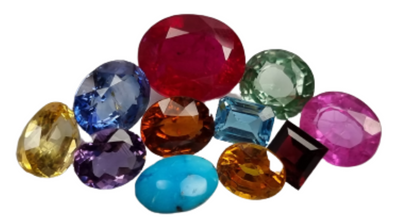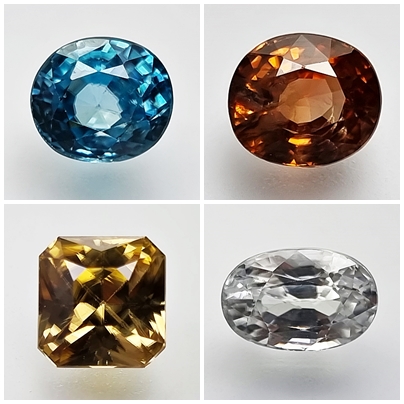Zircon Gemstone Information
Zircon, a mineral belonging to the group of nesosilicates, is renowned for its diverse applications, historical significance, and geological importance. Its name is derived from the Persian word “zargun,” meaning “golden-colored.” Zircon is primarily composed of zirconium silicate (ZrSiO4) and is often found in a range of colors including colorless, yellow, orange, red, brown, green, blue, and rarely black.
Geological Formation and Occurrence
Zircon forms in a variety of geological environments, including igneous, metamorphic, and sedimentary rocks. It commonly occurs in granitic rocks such as granite and syenite, as well as in metamorphic rocks like gneiss and schist. Zircon crystals can also be found in sand and gravel deposits derived from the erosion of these rocks.
The formation of zircon typically involves high-temperature and high-pressure conditions. Zircon crystals often crystallize early during the solidification of molten rock (magma) in igneous rocks, where they can be found as accessory minerals. In metamorphic rocks, zircon can form through the recrystallization of existing minerals under elevated temperature and pressure. In sedimentary environments, zircon grains are commonly derived from the erosion and weathering of pre-existing rocks.
Physical Properties
Zircon is known for its distinctive physical properties, including its tetragonal crystal structure and high refractive index. It has a Mohs hardness of 7.5, making it relatively resistant to scratching, and a specific gravity ranging from 4.6 to 4.7. Zircon crystals often exhibit well-defined crystal faces and may form prismatic or pyramidal shapes. The luster of zircon is typically adamantine to greasy, and it can display strong birefringence under crossed-polarized light.
Gemological Significance
Zircon is valued as a gemstone for its brilliance, fire, and range of colors. Colorless zircon, often referred to as “Matara diamond,” resembles diamond and has been used as a diamond substitute in jewelry. However, it is the colored varieties of zircon that are most prized for their beauty. Blue zircon, in particular, is highly sought after and can rival the brilliance of blue sapphire.
Zircon is commonly faceted into various gemstone cuts, including round brilliant, oval, cushion, and emerald cut. It is also used in cabochon cuts to showcase its cat’s eye and star phenomena. Zircon’s strong dispersion—the ability to split white light into spectral colors—contributes to its fiery appearance.
Industrial Applications
Beyond its use as a gemstone, zircon has numerous industrial applications due to its physical and chemical properties. One of the most significant applications is in the production of ceramics and refractory materials. Zircon sand, which consists mainly of zirconium silicate, is used as a raw material in the manufacture of ceramic tiles, sanitary ware, and refractory bricks. Zirconium compounds derived from zircon are also used in the production of foundry sands, abrasives, and investment casting molds.
Zirconium dioxide (zirconia), a synthetic form of zircon, has gained widespread use in various industrial and technological applications. It is utilized as a high-performance ceramic material in dental crowns, artificial bone implants, cutting tools, and thermal barrier coatings. Zirconia’s biocompatibility, strength, and aesthetic qualities make it an ideal material for dental restorations and medical implants.
Analytical Techniques and Dating Methods
Zircon’s robustness and resistance to alteration make it an invaluable mineral for geochronology and isotopic dating. By analyzing the uranium-lead (U-Pb) isotopic system in zircon crystals, geoscientists can determine the age of igneous and metamorphic rocks with exceptional precision. This dating method relies on the radioactive decay of uranium isotopes to lead isotopes within zircon crystals, providing insights into the timing of geological events such as magma crystallization and metamorphism.
In addition to isotopic dating, zircon is used in various analytical techniques, including electron microprobe analysis and laser ablation inductively coupled plasma mass spectrometry (LA-ICP-MS). These methods allow researchers to analyze the chemical composition and trace element concentrations within zircon crystals, providing valuable information about the geological processes and conditions of rock formation.
Geological Significance
Zircon’s abundance in the Earth’s crust and its widespread occurrence in a variety of rock types make it an essential mineral for understanding Earth’s history and geological evolution. Zircon crystals can serve as durable “time capsules” that preserve information about past geological events, such as the formation of ancient mountain ranges, the assembly and breakup of supercontinents, and the timing of magmatic activity.
Studying zircon grains in sedimentary rocks can provide insights into the provenance and geological history of sedimentary basins. By analyzing the age, composition, and morphology of zircon crystals, geologists can reconstruct ancient landscapes, track sedimentary dispersal patterns, and unravel the tectonic history of continental margins.
Astrology often assigns certain gemstones to specific zodiac signs or celestial bodies, believing that wearing these gemstones can influence one’s fate, luck, and well-being. Zircon, with its diverse colors and unique properties, has been associated with several astrological benefits and metaphysical properties. While these beliefs are not scientifically proven, they hold significance for many individuals who believe in the power of gemstones to harness cosmic energies.
Here are some astrological benefits attributed to zircon:
Enhanced Spiritual Awareness:
Zircon is believed to enhance spiritual awareness and intuition, making it a beneficial gemstone for individuals seeking spiritual growth and enlightenment. It is thought to stimulate the Third Eye chakra, located between the eyebrows, which governs intuition, insight, and spiritual perception. By wearing zircon, individuals may experience heightened awareness of their inner selves and the spiritual realms.
Emotional Stability and Balance:
Zircon is associated with promoting emotional stability, balance, and inner peace. It is believed to have a calming effect on the mind and emotions, helping individuals manage stress, anxiety, and negative emotions. By wearing zircon, individuals may experience greater emotional resilience and equilibrium, leading to improved well-being and mental clarity.
Increased Confidence and Self-Esteem:
Zircon is said to boost confidence, self-esteem, and assertiveness, making it an ideal gemstone for individuals seeking to overcome self-doubt and insecurity. It is believed to instill a sense of empowerment and courage, enabling individuals to express themselves more confidently and pursue their goals with determination and conviction.
Protection from Negative Energies:
Zircon is believed to possess protective properties that shield the wearer from negative energies, psychic attacks, and harmful influences. It is said to create a protective aura around the individual, deflecting negative vibrations and promoting a sense of safety and security. By wearing zircon, individuals may feel more grounded, protected, and spiritually aligned.
Harmonious Relationships:
Zircon is associated with fostering harmonious relationships, love, and companionship. It is believed to attract love, deepen emotional bonds, and strengthen romantic connections. Zircon is often used as a symbol of fidelity and devotion, making it a popular choice for engagement rings and anniversary gifts. By wearing zircon, individuals may experience greater harmony, understanding, and intimacy in their relationships.
Enhanced Creativity and Inspiration:
Zircon is said to stimulate creativity, imagination, and inspiration, making it a valuable gemstone for artists, writers, and creative individuals. It is believed to awaken dormant talents, expand consciousness, and facilitate the flow of creative energy. By wearing zircon, individuals may experience greater artistic expression, innovation, and originality in their endeavors.
Prosperity and Success:
Zircon is associated with prosperity, abundance, and success in various aspects of life, including career, finance, and business. It is believed to attract wealth, opportunities, and good fortune, leading to prosperity and fulfillment. By wearing zircon, individuals may manifest their goals, attract abundance, and achieve success in their endeavors.
In conclusion, zircon is believed to offer a range of astrological benefits and metaphysical properties, including enhanced spiritual awareness, emotional stability, confidence, protection, harmonious relationships, creativity, and prosperity. While these beliefs may vary among different cultures and spiritual traditions, many individuals find solace, inspiration, and empowerment in wearing zircon and connecting with its cosmic energies. Whether worn as a personal talisman or cherished gemstone, zircon continues to hold a special place in the realm of astrology and metaphysics.





